Hello dear motorbike traveller! You want to do a motorbike tour in Ireland and wonder where it is beautiful?
Page Contents (click line to jump the text)
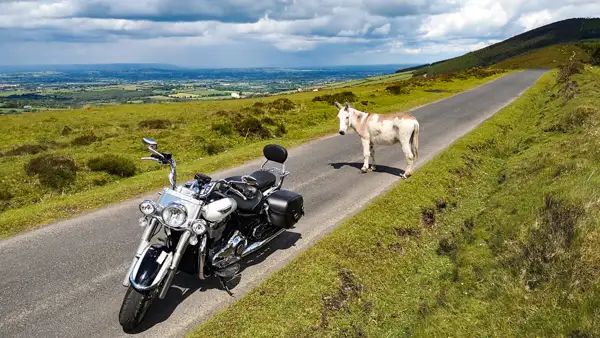
Intro
You are not alone with this question. I have a motorbike rental company in Ireland (update: had…) and therefore I hear this one and similar questions very often – and of course I answer them.
In the following I will try to give you an overview of the most important regions of the Irish island from the point of view of a motorbike traveller.
Ireland`s Ancient East
There is the term “The Ancient East” and there is “The Pale”.
The Pale was the term used in the late Middle Ages to describe Dublin and its extended fertile hinterland. The Pale was conquered and directly administered by the English, while Irish clans still ruled in other parts of the country. The English brought their nobles and they built magnificent estates, castles and later forts for defence.
Over the years, the English pushed the Irish clans further and further west, southwest and northwest until the clan structures became virtually meaningless. The English sphere of influence spread all the more widely, and with it their structures.
With the end of the Middle Ages, castles lost their importance and were replaced by magnificent castles, mansions with beautiful gardens and parks and large country estates, as well as numerous monasteries and churches.
Even before the English, the fertile region of the East was often the scene of historical events. There are Celtic places of worship, Viking towns and ports, Norman castles, battlefields of the centuries and early medieval monasteries.
This culturally strong East extends far beyond the Pale to the Northern Ireland border in the north, the Shannon River in the centre and as far as Waterford and Cork on the south coast. This is now the Ancient East, or historic east of Ireland.
What is the geography like? Flatland alternates with hilly country, especially inland. South of Dublin there are over 70km of beautiful sandy beaches. North of Dublin, beaches alternate with cliff landscapes, as does the south coast.
Extending south from Dublin is a mid-mountain range, the Wicklow Mountains, which are also a national park. Their extension, the Blackstairs Mountains, lead to New Ross and thus almost to the south coast.
What can you experience as a motorcyclist in the Ancient East? Historic sites of all kinds, sandy beaches and some rocky coastal stretches and the beautiful Wicklow Mountains, which are a really nice motorcycling area. There are some lovely towns and cities so there is plenty of variety in the Ancient East.
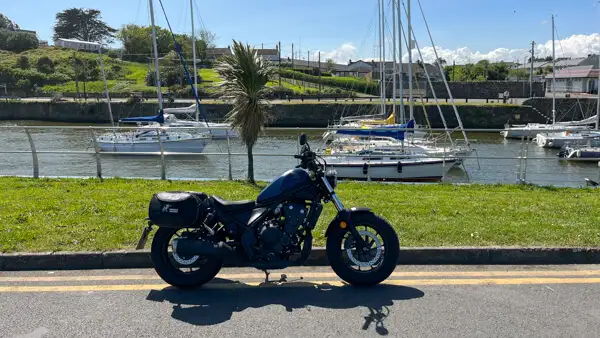
To whom would I recommend the East?
If you’re riding with a pillion and don’t just want to spend the whole day on the motorbike, but are looking for nice destinations to hit, this is the place for you.
If you are interested in culture, you will also find many nice places to visit. If you only have a few days to spend in Ireland, I wouldn’t go to the west either, but stay in the east.
And if you already know the West and are thinking about a second tour of Ireland, this might also be a good idea for you.
Another tip: In the “Sunny South East”, i.e. on the south-east coast, there is only about half as much rainfall as on the west coast. This is the sunniest and warmest region in Ireland – hence the name.
The Southern Wild Atlantic Way
The southern Wild Atlantic Way is breathtakingly scenic! In the southwest, several peninsulas point into the wild Atlantic. The cliffs are high and the surf breaks foamily against them.
The Wild Atlantic Way, over 2500km long, is a string of beautiful coastal roads from the northern tip (Malin Head) of Ireland to Kinsale in the south. It does not always run along the coast, but very often.
The wind can be very strong at times, bringing showers, but in the summer months these are usually only short cool downs and then the weather changes again.
If you cut all the peninsulas short because you want to drive around the whole island in a week, then you’ve really screwed up your travel planning! In one week you can barely do the southern WAW, for the northern WAW you can add another week.
Take your time in this region, ride the bays at your leisure and ride the peninsulas at your leisure – or at least part of them.
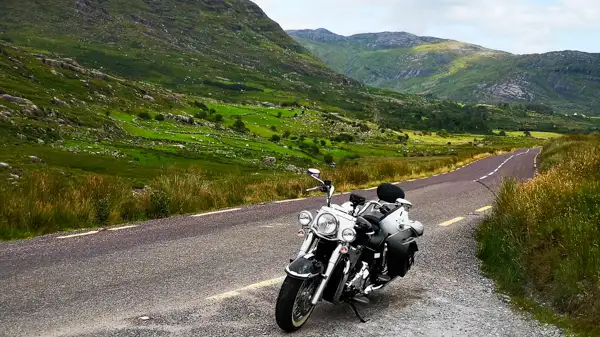
There is also a beautiful low mountain range, the Killarney National Park – very nice to drive through, not just around (Ring of Kerry).
The barren “moonscape” of the Burren is also worth seeing – it’s a small barren hill region south of Galway.
There are also a few castles along the way, but the WAW is all about the beautiful coastline. In the southwest weather is a bit milder and there tends to be more tourism here than in the northwest and also more sightseeing.
So if you want to experience spectacular coastlines, combined with a bit of sightseeing and a bit of people, pubs and music in the evening, then the southern Wild Atlantic Way is for you.
The northern Wild Atlantic Way
The northwest is a little cooler than the southwest and it can rain more.
There is less tourism, fewer cultural highlights and actually mainly landscapes and coasts.
If you enjoy having the road to yourself from time to time, if you appreciate the rugged charm of northern countries, if you like the Scottish Highlands, or Scandinavia, this is the place to be!
The coasts and peninsulas are beautiful, and on the beaches and bays you will find azure blue water that you would rather expect in the Caribbean. If you’re lucky, you’ll see whales passing by.
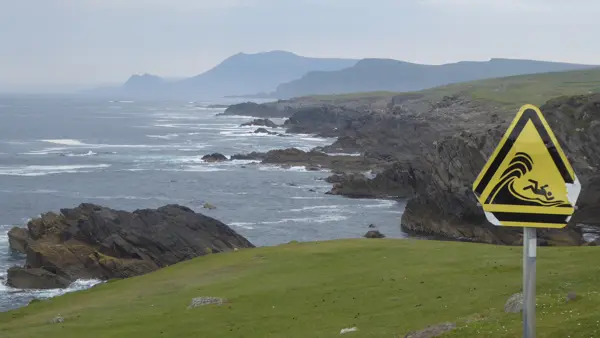
The high moorland mountains are a little reminiscent of the Scottish Highlands. Geographically, you are now at the height of southern Scotland.
Trout and salmon spawn in the rivers of Ballycroy National Park and off the coasts you can see rows of buoys from oyster and mussel farms.
There are several beautiful low mountain ranges for us motorcyclists to enjoy: The mountains of Connemara, the hill country of Mayo and Glenveagh National Park.
In the north, it’s all about experiencing nature. There are also a few nice towns here, but it’s more about the riding experience, the somewhat rougher nature and the “northern feeling”.
Northern Ireland
Northern Ireland belongs to Great Britain and is therefore, unlike the Republic of Ireland, no longer part of the EU. The speed limits are in miles per hour and you pay in pounds.
Although there is an external EU border here, it is hardly recognisable. Only small signs mark the border and it is easy to miss. Accordingly, it is uncomplicated for you to drive into Northern Ireland.
Northern Ireland is a divided country. Residents of Irish origin (Catholics) and residents of English-Scottish origin (Protestants) live side by side, but not necessarily with each other.
The Northern Ireland conflict from the 1970s to the 1990s – does that mean anything to you? At that time there were many violent clashes between these population groups with bombings and British military operations. It’s less about denomination and more about whether Northern Ireland should be part of Ireland, or part of Britain.
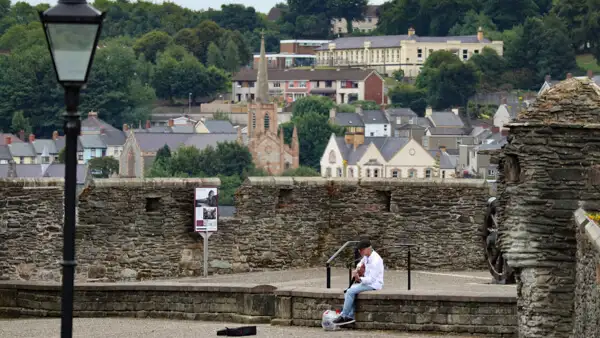
Hotspots of these clashes were Londonderry (Northern Irish name) or Derry (Irish name, and Belfast. I still find both cities interesting to visit, or perhaps because they are special.
As a tourist, you can travel safely in Northern Ireland today, but the traces of this conflict are still visible and palpable – a strange mood seems to lie over the country. One senses less cheerful insouciance, as in Ireland.
The tourism industry would rather forget this chapter and stirs the advertising drum fiercely. Especially the Causeway Coastal Route, the quite beautiful north coast, is heavily advertised. I was there several times, but each time there were so many English tourists that I didn’t stay long at the Causeway – it was just too busy for me.
My insider tip is the North Antrim Coastal Route, a small, fantastically beautiful road right by the sea that stretches from Torr Head in the northeast to Larne, north of Belfast.
The hinterland of the north-east coast is also very beautiful for motorcyclists to ride. Many small valleys and gorges criss-cross the hilly landscape.
The coast southeast of Belfast, up to the border with Ireland, is also very beautiful to ride. Especially the bay of Carlingford with the Mourne Mountains in the background is worth seeing.
The Midlands and the Shannon River
When you drive through the Midlands, you experience the original Ireland, away from the tourist crowds. Most tourists are probably on the Wild Atlantic Way and then in the larger cities.
Of course, there are also B&Bs and other accommodation inland, but you already feel that life around you has a different rhythm. More leisurely, the activities revolve around what you do in a small town in the country – without much fuss about tourism.
Here, the clocks tick slower and you notice how you also find peace inside – a beautiful experience.
The towns are often colourful and cosy, the countryside is mostly hilly and the driving impressions change from pastures with hedges and walls, over streams and lakes, small woods, lonely homesteads, tiny one-street villages, colourful small towns and pastures again…
You’ll see more sheep, cows, horses and maybe donkeys than inhabitants and the small roads wind through the hills in many curves and are a delight for motorcyclists.

Can I recommend a particular route? Not really – the best tip I can give you is to take your time and stay away from motorways and national roads (N). then you will always get such impressions.
If that gets too boring for you, you can also stick to the River Shannon. At over 360km long, it is the longest and most important river in Ireland. For thousands of years it was one of the most important transport routes on the island. Today, it is mainly recreational captains who sail it, in houseboats, kayaks or sailing boats.
There is life there and with it infrastructure: towns like Carrick on Shannon are nice and lively and certainly worthwhile for an overnight stay.
In summer, however, it can get very busy on the lakeshores, especially at weekends, as Irish families also use them for swimming and as a local recreation and excursion destination.
Would I recommend a motorbike trip just through the Midlands or along the Shannon? Yes, in combination with a stretch of the Wild Atlantic Way – it’s just too beautiful and too spectacular to miss out completely.
So how do I start now?
If you have never been to Ireland before and have at least a week to spare, I would recommend the southern Wild Atlantic Way. On the way back, you can spend a night in Dublin City and then you’ll have a really great impression of Ireland.
Next year you can come back and do the northern Wild Atlantic Way, maybe in combination with Northern Ireland. On the way north or back you can take a leisurely drive through the Midlands.
For a short trip (4-5 days) you can do the Ancient East (in combination with Dublin).
If you have 12 days, you can do the whole Wild Atlantic Way, and in 14 days you can drive around the island.
And if you’ve already seen the WAW, you can also combine a trip to Northern Ireland with Scotland – the crossing only takes two hours by ferry. I would recommend at least 10 days for that.
As you can see, there are good reasons to come back to the Emerald Isle in the azure Atlantic – I wish you a great trip!
More interesting articles for you
THE BEST MOTORBIKE HIGHLIGHTS IN IRELAND’S WEST
THE BEST MOTORBIKE HIGHLIGHTS IN IRELAND’S NORTH
THE BEST MOTORBIKE HIGHLIGHTS IN IRELAND’S SOUTHEAST AND SOUTH
PREPARING FOR A MOTORBIKE TRIP IN IRELAND – ROUTE SELECTION AND NAVIGATION
Photo credits cover photo: Wild Atlantic Way road sign, photo by Ulrich Knüppel-Gertberg, ( www.irland-insider.de and www.ireland-insider.com)